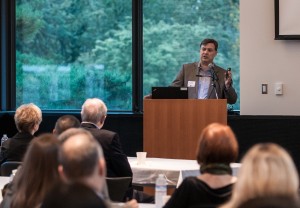Money follows vision
As the executive director of the Seattle Symphony Orchestra, Simon Woods must strike a delicate balance between the business and artistic sides of his organization. While for-profits may be based on creating value, non-profits are centered on creating “impact.” So, there’s always a struggle when deciding to “do things that lose more money, but make more impact,” Woods said.
 On October 29, Woods presented at the Leaders to Legends lecture series and discussed the recent challenges and transformations the Seattle Symphony faced under his direction. According to Woods, the previous decade was not an easy one for the organization, beset by external pressures like the recession, and internal friction from the misalignment of artistic vision among members. Symphonies are large and fragile organizations: “They’re like giants—they fall hard,” he said.
On October 29, Woods presented at the Leaders to Legends lecture series and discussed the recent challenges and transformations the Seattle Symphony faced under his direction. According to Woods, the previous decade was not an easy one for the organization, beset by external pressures like the recession, and internal friction from the misalignment of artistic vision among members. Symphonies are large and fragile organizations: “They’re like giants—they fall hard,” he said.
Woods came to Seattle in May 2011, during “a moment of great artistic potential aligned with a moment of financial peril,” he said. Together with Music Director Ludovic Morlot, Woods has been instrumental in defining and executing a vision to establish the Seattle Symphony as a dynamic, forward-looking, and community-focused organization. Woods worked previously as Chief Executive of the Royal Scottish National Orchestra, President and CEO of the New Jersey Symphony Orchestra, and Vice President of Artistic Planning and Operations at The Philadelphia Orchestra. He’s spent the better part of 20 years on the business side of music.
Woods explained the six-part plan that helped turn things around for the Seattle Symphony.
- Change the brand from traditional to contemporary. According to Woods, Seattle is a progressive city, so it needs a progressive orchestra.
- Plan boldly. To match the new brand, the Seattle Symphony started taking more risks in its programming by performing more contemporary pieces, playing in different spaces, and collaborating with rock, pop, and rap artists.
- Control the messaging. Woods underscored the importance of staying on message, so that the organization could present itself as “the orchestra of Seattle, not just in”
- Work to build a financial bridge to the future through fundraising and re-budgeting.
- Focus on the long term. The Seattle Symphony didn’t ask its constituents for help now, but rather for help becoming a great organization for the next generation.
- Gather morale. Woods wanted to “build an internal culture of collaboration and harmony.”
So far the plan has paid off, and the Seattle Symphony has balanced its budget for three years in a row. When you “invest in reflecting the values of your city, not surprisingly, you get rewarded,” Woods said. More significantly, the organization’s impact has not diminished. In fact, the Seattle Symphony has a greater impact than ever, as demonstrated by the launching of new projects like its music education program, prison outreach program, and the creation of a record label, to name a few.
The challenges may not be over, but Woods remains optimistic. “As the world speeds up, there is more and more need for beauty and peace in life,” he said.
